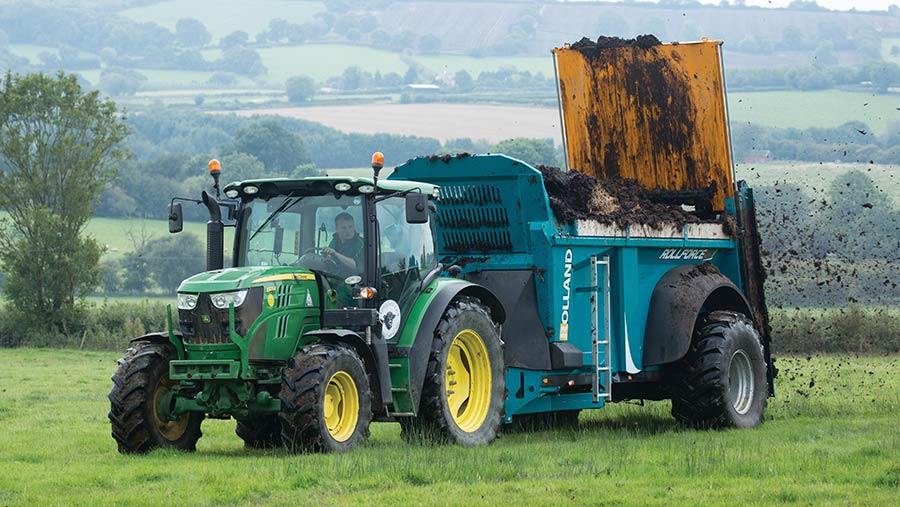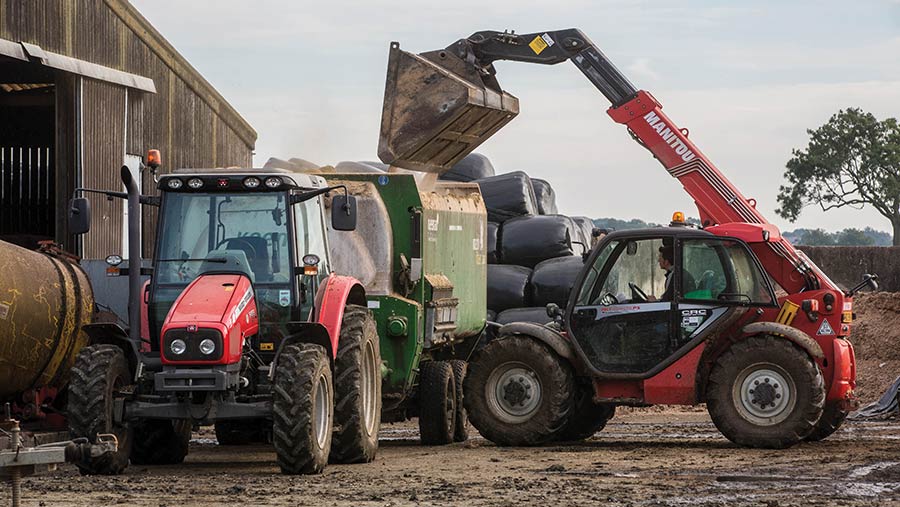Sharing livestock machinery: Advice and options
 © Tim Scrivener
© Tim Scrivener Justifying a new tractor or baler for a beef and sheep enterprise on a family farm is becoming increasingly hard as costs inflate to erode margins.
The depreciation and power and machinery cost averaged more than £240 a cow in Quality Meat Scotland’s latest profitability report for upland suckler farms selling weaned calves.
And according to the Farm Business Survey for the 2020-21 tax year, machinery depreciation, repairs and other expenses cost £469.49/ha (£190/acre) for a small, lowland grazing farm in England, with machinery, fuel and oil at £107.24/ha (£43.20/acre).
Studies of long-established machinery sharing initiatives in Sweden and the southern plains of the US found cost savings were as high as 15% and 41%, respectively.
With the subsidy landscape in UK farming changing, Farmers Weekly looked at the array of machinery sharing options that have developed in the past 80 years.
See also: Sharing kit with your neighbours: Advice on getting started
Machinery sharing options
Tool lending networks
Some of these arrangements are as old as the tools themselves and simply rely on lending equipment to neighbours.
This is integral to some communities and extends to labour at hay time or shearing, and is part of the traditional fabric of the countryside.
Direct Co-ownership
Farmers purchase equipment and share it, without forming a separate legal entity. Around the world, such setups tend to stem from good relationships between friends, family, or neighbours.
These arrangements can be managed casually, but many benefit from a contract and clear terms.
Shared equipment businesses
Some businesses are created through making money from sharing and hiring equipment, for example:
Sustainable Agriculture Tool Lending Library
In North Carolina, 11 farmers within a 45-mile radius share vegetable-growing equipment, paying £250 a year and an annual maintenance day.
Hello Tractor
This “Uber for farmers” links tractor owners with farmers via a digital app. Just like using an app to call a taxi, the app arranges a tractor for a fee when cultivation or harvest work is required.
About 800,000 farmers have been serviced by Hello Tractor, which operates in 15 African countries as well as Pakistan, Bangladesh, Guatemala, and Jamaica.
Co-operatives
Coopératives d’Utilisation de Matériel Agricole (co-operatives for the use of farm implements) (Cuma) emerged in France after the Second World War and have been emulated in Quebec and Ontario.
They provide the legal framework to pool machinery and membership fees cover the cost of advisory staff to help small family farms to mechanise.
- In France, there are more than 12,000 Cumas with an average size of 25 farmers
- About 50% of French farmers are members of a Cuma
- All Cumas sit under a national organisation, and one of 10 regional federations and 65 local federations.
State and non-profit programmes
In the US state of Maryland, local district money has subsidised the rental of farm equipment to a local dealer that did not previously rent machines.
Another initiative in the state operates a rental system, providing training in operation. And in New Hampshire, a no-till drill, ash spreader, cultivator and soil aerator were made available to rent through the District Conservation office for a nominal fee.
Advice on machinery sharing and direct co-ownership
James Severn, a farm adviser in northern England for GSC Grays, believes there are good reasons to consider collaborative agreements around machinery.
“With direct support [Basic Payment Scheme] reducing and ultimately going, and with machinery, equipment and spare parts becoming increasingly expensive, sharing resources could be a valuable decision in these volatile times,” says James.
“The benefits of a good machinery-share agreement are equally applicable to, and effective for, livestock and arable sectors.”
James has worked on several machinery sharing agreements, and says that, where there is imagination and a shared will to make it happen, any key item of machinery could be shared, along with running costs.
To make a machinery sharing agreement work, he advises the following:
Starting out
- You will need to work with a like-minded person
- Find somebody with common goals, for example, cost saving, better technology
- Develop clear roles and responsibilities
- Put effort into good communication channels
- Have a simple programme of management meetings, recording decisions taken
- Simplicity and common sense
- A clear working agreement
- Teamwork.
Writing an agreement
A written agreement is the best way to manage the process. It should be clear and straightforward and state the following:
- The parties involved
- Details of the machine (description, make, model, age, and value). This might be included in an appendix or schedule to the agreement
- How the ownership will be shared, for example, 50-50, 60-40
- Where the machinery will be kept
- Who is responsible for its safekeeping
- How running costs (repairs, servicing, maintenance, insurance) will be shared. Many arable farming arrangements now share combine harvesters, with costs shared according to acreage covered
- Who carries the cost of repair if it is damaged, for example, “If you break it, you fix it”
- Provisions for replacement
- How to end the relationship, either by a buyout, selling and sharing the residual value or starting over again.
Consider the benefits
- Capital purchase shared
- Running costs shared
- Accessing better technology than would otherwise be affordable
- Leads to other sharing/costs saving opportunities
- It can be fun and engaging. Don’t underestimate the importance of fun. Farming can be a lonely business. Sharing something means you are talking, communicating, and sharing the challenges of day-to-day farming as well as the machine itself
Consider the challenges
- Timing clashes (they want it when I do). Usually, planning to use the machine at different times resolves the issue
- Loss of independence. What happens if there is a change of system or enterprises and the machine is no longer needed by one party? Consider how to end the agreement and how the value or cost of the item is managed if one party no longer needs the item.
Example: Sharing a feeder wagon

© Tim Scrivener
Two relatively small-scale livestock farms, one dairy and the second farming beef and sheep, shared the following key objectives:
- To improve the efficiency of their feeding systems, saving time and effort
- To improve the quality of ration fed by moving to complete diet feeding
- To address staffing issues
- To use new technology.
They each wanted to purchase a feeder wagon, but neither could fully justify the cost on their own.
The solution was to share the purchase on a 50-50 basis, meaning each halved their investment cost and could share usage of the machine together with ongoing running costs.
Some farmers are now sharing silage making equipment, muck spreaders and even milking parlours to manage the fixed costs of their enterprises, says farm adviser James Severn of GSC Grays.
Their primary concern was that they would both want to use the feeder wagon at the same time.
The solution here was simply to dovetail feeding times around the morning feeding routine of the dairy unit so there was no clash in demand.
This type of arrangement can be simple to plan, establish and maintain.

